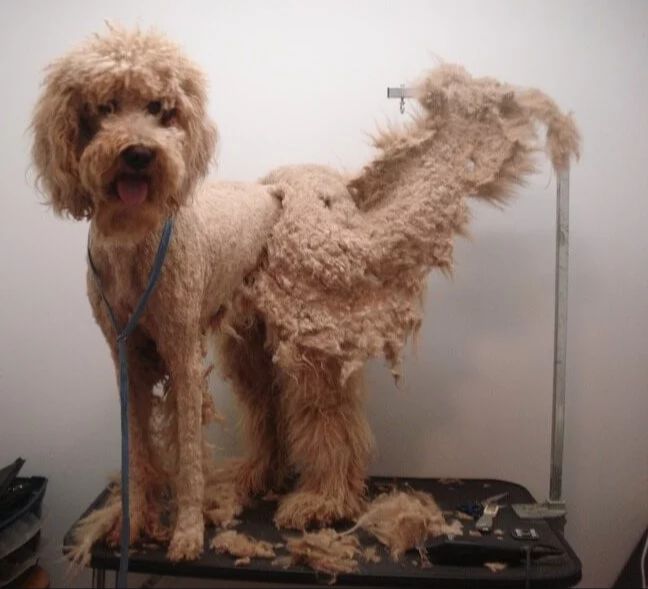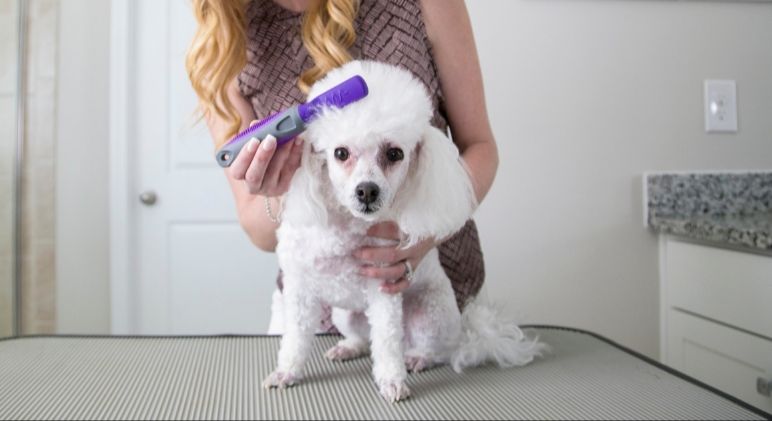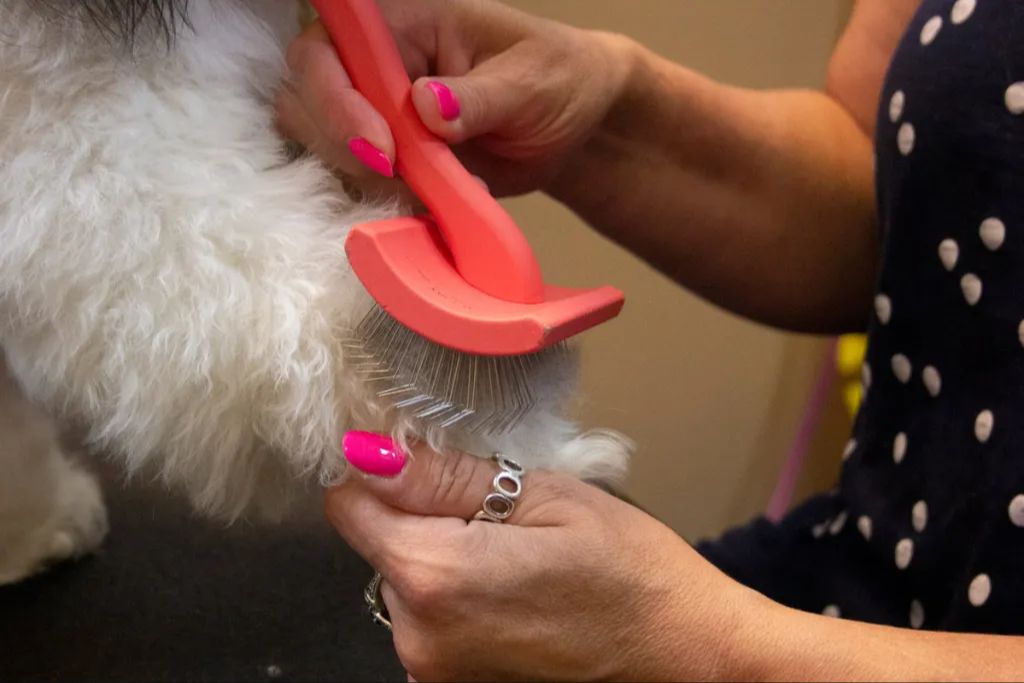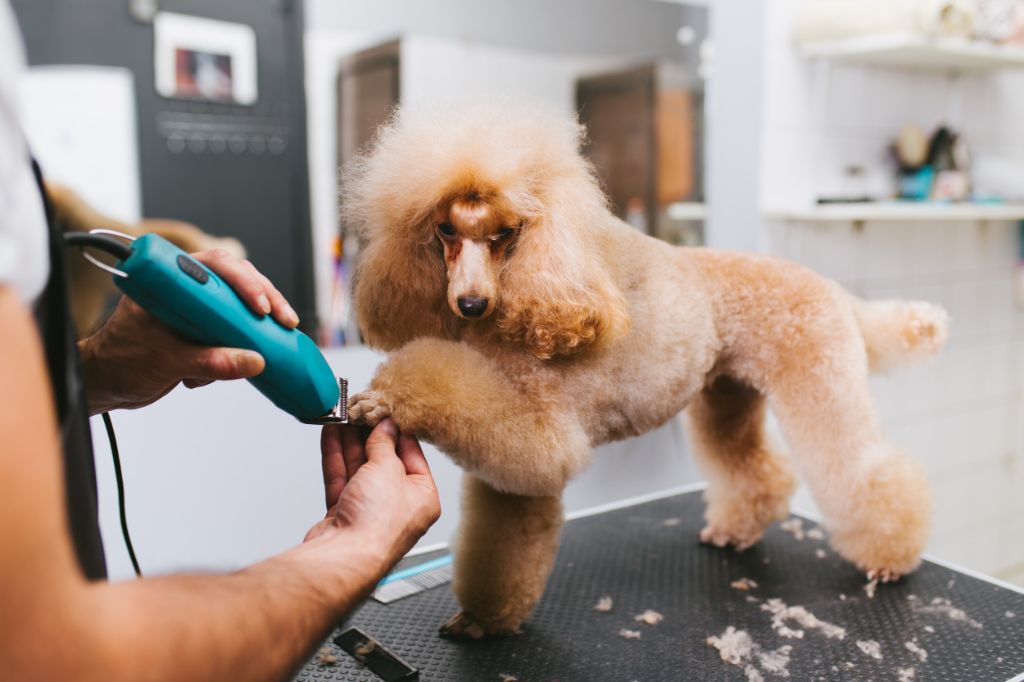Introduction
Matted fur is a common issue that dog owners face. Severely matted fur can be painful for dogs and lead to skin damage if left untreated. This article provides an overview of the causes of matted fur in dogs, the potential dangers, whether professional groomers can safely shave down a severely matted dog, tips for trying to de-mat fur at home before resorting to shaving, when to seek professional help, prevention tips, how to groom breeds prone to matting, signs your dog needs a groomer, and more. The goal is to provide dog owners with a comprehensive guide to dealing with matted fur in dogs and determining the best solutions for their pet’s health and comfort.
What Causes Matted Fur in Dogs?
There are several common causes of matted fur in dogs:
Lack of regular brushing and grooming is a major cause of mats, especially in long-haired breeds. When fur is not brushed, loose hairs can tangle around each other and form knots near the skin that gradually tighten into mats (1).
Certain skin conditions like allergies or infections can cause dogs to excessively lick, bite, and scratch at their fur. This disrupts the fur and allows mats to form more easily (2).
Aging dogs may have arthritic joints that prevent them from properly grooming themselves. Their fur can become matted due to the inability to lick and nibble at their coats (1).

Long-haired dog breeds like Shih Tzus, Poodles, Lhasa Apsos, and Pekingese are prone to mats as their long fur can easily twist and tangle if not frequently brushed (3).
Other potential causes include outdoor debris getting caught in the fur, improperly drying after a bath, and sticky substances matting the fur. Overall, lack of maintenance and grooming is the primary reason dogs get severe mats.
Dangers of Severely Matted Fur
Severe matting in a dog’s fur can cause a number of health risks and problems. Matts trap moisture, dirt, and debris next to the skin, leading to painful skin irritations and infections. Common skin issues caused by matting include:
- Hot spots
- Rashes
- Sores
- Lesions
Bacteria and fungus can thrive in the trapped moisture, worsening skin infections. Studies show matted fur gives parasites like fleas and ticks a place to hide and breed. An infestation can quickly get out of control under mats.
Thick mats can also restrict movement and mobility. Matting on the legs or belly may cause limping or difficulty walking. Joints can become painfully inflamed from the constant pulling and tugging of mats. In extreme cases, blood flow can even be restricted.
Matting causes immense discomfort and can become increasingly painful over time. Dogs may exhibit signs like whining, biting at their skin, isolating themselves, or losing their appetite. Severe matting left untreated can negatively impact quality of life.
Can Groomers Safely Shave Down a Matted Dog?
Groomers are trained to safely shave down matted fur on dogs, however it can be a challenging process that requires care and expertise [1]. Severely matted coats take a long time to shave off and there is a risk of nicks, cuts or irritation if the groomer works too quickly [2]. In extreme cases where the mats are very tight and dense, anesthetic may be required to fully shave the dog without pain or injury. But in most situations, a skilled professional groomer can safely remove matted fur with patience and the proper tools. The end result is a much more comfortable dog free of restrictive, painful mats.
Tips for De-matting Without Shaving

While it may seem like shaving is the easiest solution for a severely matted dog, there are some techniques you can try first to de-mat your dog’s coat without having to shave it down completely:
Frequent brushing is key to preventing mats from forming in the first place. Use a slicker brush and metal comb to brush all the way down to your dog’s skin at least once per week. Pay extra attention to areas prone to matting like the ears, armpits, and hind legs.
Invest in a de-matting tool which can help break up mats and work loose hair out gently without pulling on your dog’s skin. Always brush outwards from the center of the mat.
Make a diluted spray conditioner by mixing equal parts conditioner and water in a spray bottle. Mist onto mats to help soften and loosen them before brushing. Avoid using conditioner if you plan to bathe your dog soon.
Skip baths as much as possible when dealing with mats, as wet fur will tighten up into dense mats as it dries. If you must bathe, use a moisturizing shampoo and thoroughly brush out the coat before and after.
When to Seek Professional Help
If your dog has severe or widespread matting close to the skin, it’s best to seek professional grooming help as soon as possible. According to this source, severely matted fur can pull and tear the skin, leading to wounds, infections and discomfort for the dog. Trying to cut out severe mats at home can be very difficult and may cause injury to the dog’s skin. Professional groomers have the proper tools and experience to safely de-mat dogs with minimal discomfort.
Signs that your dog needs professional de-matting include:
- Matted fur covering large portions of the body
- Tight mats close to the skin that you cannot easily separate
- Redness, sores or scabs on the skin under mats
- Signs of discomfort like whining or shivering when mats are touched
- Difficulty moving due to restricted range of motion from mats
- Strong odor coming from mats
If you notice any of these warning signs, don’t delay – consult a professional groomer right away. They can assess the severity of the matting and determine the safest approach, whether that involves de-matting, closely shaving the dog, or a combination of techniques for the dog’s comfort and health.
At-Home Prevention
Preventing mats from developing in your dog’s fur starts with a proper at-home grooming routine. Here are some tips to keep your dog’s coat healthy and tangle-free:
Regular brushing is essential. For long-haired breeds, daily brushing is ideal. For short-haired dogs, aim for 2-3 times per week. Use a slicker brush and metal comb to reach deep down to the undercoat. Pay extra attention to friction areas like behind the ears, armpits and back legs. (1)

Bathe your dog regularly, but not too often. Over-bathing can dry out the coat. Every 2-4 weeks is sufficient for most dogs. Always use a moisturizing shampoo and conditioner. Thoroughly rinse and dry the coat afterwards. (2)
Maintain a healthy diet with omega fatty acids. Foods like salmon, sardines and chia seeds support skin and coat health from the inside out. Ask your vet about supplementing with fish oil. (3)
Invest in grooming tools like detangling sprays, texturizing powders and deshedding tools. Only use gentle, detangling products to avoid breakage. Always read ingredient labels. (1)
Prevent mats in problem areas by clipping the fur short around the paws, belly and behind the ears. Never shave down to the skin which can damage the coat long-term. (2)
Catch tangles early before they turn into tight mats. Carefully work apart small tangles with your fingers or a seam ripper. Never pull or cut mats – this can hurt the dog.
Grooming for Matted Dog Breeds
Certain dog breeds are more prone to matted fur and require more frequent professional grooming to prevent issues. This is due to having a long, thick, or curly coat that can easily tangle and trap debris close to the skin.
Examples of higher maintenance dog breeds that are prone to mats include:
- Poodles
- Doodles like Labradoodles and Goldendoodles
- Terriers with long fur like Yorkshire Terriers
- Shih Tzus
- Lhasa Apsos
- Maltese
For these breeds, professional grooming every 4-8 weeks is recommended to keep the coat free of mats and tangles. In between full grooming sessions, daily brushing at home can help prevent matting from building up.
Allowing these breeds to go too long without brushing or professional grooming can allow mats to become tight and severe near the skin, leading to discomfort and potential skin infections. Being proactive with frequent grooming is key to maintaining their coat health.

Signs Your Dog Needs a Groomer
There are several signs that indicate it’s time to take your dog to a professional groomer. Matted fur is one of the most common reasons dogs need grooming. Matting occurs when loose fur gets tangled and forms clumps, which can be uncomfortable and even painful for dogs. Overgrown fur is another sign, as excessively long hair can collect dirt, debris, and parasites. Dogs with overgrown fur may also have problems seeing and moving around comfortably.
Skin irritation like redness, bumps, or hot spots can indicate an issue that requires grooming attention. An unpleasant odor, even after bathing, is a red flag for skin infections or other problems a groomer can identify and treat. Excessive shedding beyond the normal for that breed of dog is another grooming need. Shedding can become extreme when the undercoat is not removed regularly.
In addition to matting, overgrown fur, skin irritation, odor, and excessive shedding, other signs your dog needs professional grooming include overgrown nails that clack loudly on floors, discharge or swelling around eyes or ears, and anal gland impaction needing expression. An experienced groomer can tidy your dog’s coat, trim nails, check for skin issues, and tend to all aspects of grooming care.
Conclusion
In summary, matted fur on dogs is a common issue that requires regular grooming and brushing to prevent. Severely matted coats can be dangerous for dogs if left untreated, leading to skin infections, parasites, and discomfort. Professional groomers are equipped to safely de-mat dogs using techniques like de-tangling sprays, slicker brushes, and clippers, but prevention through frequent brushing and combing at home is key.
Grooming plays an important role in maintaining dogs’ health and comfort. By establishing a regular grooming routine, providing proper tools, and inspecting your dog’s coat often, mats can be avoided or managed before becoming severe. Seeking professional help for heavily matted dogs minimizes risks of injury during the de-matting process. With vigilance and proper care, dog owners can keep their pets’ coats free of problematic tangles and mattes.
The takeaway is that consistent grooming is vital for dogs’ wellbeing. Mats left unattended lead to discomfort and health issues, so being proactive with brushing, combing, and professional grooming as needed allows dogs like [insert dog breed] to live happily and healthily.
